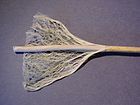- Acrylic fiber
-
Acrylic fibers are synthetic fibers made from a polymer (polyacrylonitrile) with an average molecular weight of ~100,000, about 1900 monomer units. To be called acrylic in the U.S, the polymer must contain at least 85% acrylonitrile monomer. Typical comonomers are vinyl acetate or methyl acrylate. The Dupont Corporation created the first acrylic fibers in 1941 and trademarked them under the name Orlon.[1]
Production
The polymer is formed by free-radical polymerization in aqueous suspension. The fiber is produced by dissolving the polymer in a solvent such as N,N-dimethylformamide or aqueous sodium thiocyanate, metering it through a multi-hole spinnerette and coagulating the resultant filaments in an aqueous solution of the same solvent (wet spinning) or evaporating the solvent in a stream of heated inert gas (dry spinning). Washing, stretching, drying and crimping complete the processing. Acrylic fibers are produced in a range of deniers, typically from 0.9 to 15, as cut staple or as a 500,000 to 1 million filament tow. End uses include sweaters, hats, hand-knitting yarns, rugs, awnings, boat covers, and upholstery; the fiber is also used as a precursor for carbon fiber. Production of acrylic fibers is centered in the Far East, Turkey, India, Mexico, and South America, though a number of European producers still continue to operate. All US producers have ended production. Former U.S. brands of acrylic were Acrilan (Monsanto), Creslan (American Cyanamid), and Orlon (DuPont). Other brand names that are still in use include Dralon (Dralon GmbH).
Textile uses
Acrylic is lightweight, soft, and warm, with a wool-like feel. Or it can be made to mimic other fibers, such as cotton, when spun on short staple equipment. Some acrylic is extruded in colored or pigmented form; other is extruded in "ecru", otherwise known as "natural," "raw white," or "undyed." Pigmented fiber has highest light-fastness. Its fibers are very resilient compared to both other synthetics and natural fibers. Some acrylic is used in clothing as a less expensive alternative to cashmere, due to the similar feeling of the materials. Some acrylic fabrics may fuzz or pill easily. Other fibers and fabrics are designed to minimize pilling. Acrylic takes color well, is washable, and is generally hypoallergenic. End-uses include socks, hats, gloves, sweaters, home furnishing fabrics, and awnings.
Acrylic is resistant to moths, oils, chemicals, and is very resistant to deterioration from sunlight exposure. However, static and pilling can be a problem in certain fabrications.
Acrylic has a bad reputation amongst some crafters who knit or crochet; acrylic yarn may be perceived as "cheap" because it is typically priced lower than its natural counterparts. The fiber requires heat to "block" or set the shape of the finished garment, and it isn't as warm as alternatives like wool. Some knitters also complain that the fiber "squeaks" when knitted. On the other hand, it can be useful in certain items, like garments for babies, which require constant washing, because it is machine-washable.
Acrylic can irritate the skin of people with dermatological conditions such as eczema but this is unusual.
Leading US spinners include National Spinning Co., Inc. Leading acrylic fiber producers include AkSa (Turkey), Montefibre (Spain), Dralon (Germany), and Kaltex (Mexico).
References
Fibers Natural 
Synthetic CelluloseCategories:- Synthetic fibers
- Plastics
Wikimedia Foundation. 2010.
